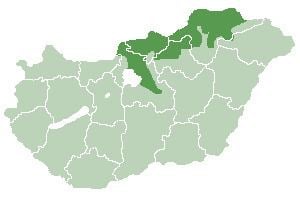Mountains Csóványos | ||
 | ||
North hungarian mountains mvi 0523
The North Hungarian Mountains (sometimes also referred to as Northeast Hungarian Mountains, Northeast Mountains, North Hungarian Highlands, North Hungarian Mid-Mountains or North Hungarian Range, Hungarian: Északi-középhegység) is the northern, mountainous part of Hungary. It forms a geographical unity with the Mátra-Slanec Area, the adjacent parts of Slovakia. It is a separate geomorphological area within the Western Carpathians. The mountains run along in Northeast Hungary, and along the eastern parts of the Hungarian-Slovak border in a broad band from the Danube Bend to the town of Prešov.
Contents
- North hungarian mountains mvi 0523
- Map of GyC3B6ngyC3B6ssolymos North Hungarian Mountains 3231 Hungary
- North hungarian mountains mvi 0605
- Subdivisions
- Description
- Natural resources
- National parks
- Protected areas
- References
Map of Gy%C3%B6ngy%C3%B6ssolymos, North Hungarian Mountains, 3231 Hungary
North hungarian mountains mvi 0605
Subdivisions
The area consists of the following geomorphological units:
Ranges of the adjacent Mátra-Slanec Area in Slovakia:
Description
The North Hungarian Mountains begin with the mountain range of Börzsöny, adjacent to the Danube Bend, where it meets the Transdanubian Mountains.
The Börzsöny range is about 600 km² in area, and mainly of volcanic origin. The highest peak is the Csóványos (938 m).
The next range towards the east is the Cserhát, with the same geological composition as the Börzsöny. Erosion here was more severe: these are mere hills and comprise the lowest part of the North Hungarian Mountains. The highest point is the Naszály (654 m).
Kékes, the country's highest peak at 1014 metres, is located in the next range, Mátra. However, the range's average height is only 600 metres, less than that of the neighbouring Bükk. Mátra is also of volcanic origin.
The Bükk is a limestone range; it has the highest average height in Hungary. It is rich in caves, some of which were inhabited in ancient times.
The Aggtelek Karst area is a geologic formation spanning the Hungarian-Slovakian border, and the reason for the Caves of Aggtelek Karst and Slovak Karst World Heritage Site, and the Hungarian Aggtelek National Park. Hungary's most popular cave, the Baradla, is located there.
The Zemplén Mountains are again of volcanic origin; the soil's high quality favours viticulture.
